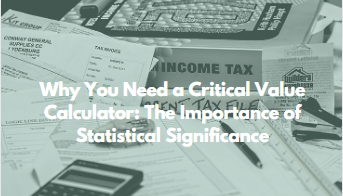
A key idea in research is statistical significance, which enables us to determine whether a study’s findings are meaningful or simply the result of chance. Use statistical tests to compare the observed data to what would anticipate seeing if there were no real effects in order to arrive at this conclusion. In order to decide whether the results are statistically significant, anyone can use a critical value calculator to help determine the critical value for a specific statistical test.
A critical value can be used to indicate how far the data you’re working with deviates from the average value of all the available data. You can increase your knowledge of cumulative probability and get ready for more difficult concepts by knowing how to use a critical value.
Learning about Statistical Significance
The likelihood that the observed results are not the result of chance is referred to as statistical significance. We use a statistical test that computes a p-value, which represents the likelihood of getting the observed results in the absence of a real effect, to determine statistical significance. We deem the results to be statistically significant if the p-value is below a predetermined cutoff, typically 0.05.
Many people have the impression that a significant result indicates that the effect is significant or large, or that a non-significant result indicates that there is no effect. In reality, statistical significance does not reveal the magnitude or significance of the effect; it only indicates whether the observed results are likely to be the result of chance.
Impact of Critical Value on Statistical Significance
In a statistical test, the critical value is the amount that separates the rejection region from the non-rejection region. It depends on the sample size and the type of test being used, as well as the level of significance (alpha) and the degrees of freedom. To determine whether the results are statistically significant, we compare the test statistic using the critical value.
Different types of critical values exist for various test types, including t-tests, F-tests, and chi-square tests. The kind of test being used and the level of significance picked both influence the critical value selection.
Manual Critical Value Calculation
Critical value determination manually can be difficult, particularly for complicated tests or large sample sizes. The calculation process is susceptible to errors, which can result in incorrect results or the waste of resources. Manual calculations can also be time-consuming and demand a high level of expertise.
The Benefits of Critical Value Calculator
The benefits of using a critical value calculator in statistical analysis are numerous. Here are some of the main advantages:
Reduced risk of errors
It can be difficult to manually calculate critical values, particularly for complicated tests or large sample sizes. Calculation errors frequently result in incorrect conclusions or the waste of resources. Critical value calculators automate the procedure, lowering the possibility of mistakes and guaranteeing the accuracy of the outcomes.
Time-saving
Even for small datasets or straightforward statistical tests, manually calculating critical values can take a lot of time. By using a critical value calculator, researchers and analysts can concentrate on other areas of their work and save a huge amount of time.
Cost-effective
Traditional statistical analysis software can be costly and difficult to use proficiently. Comparatively, critical value calculators are frequently free or inexpensive, making them available to a wider user base. They also do away with the requirement for specialized software or knowledge, further lowering costs.
Versatility
A wide variety of statistical tests, including t-tests, F-tests, and chi-square tests, can be performed using critical value calculators. They are a helpful tool for numerous types of research because they can be used with various sample sizes and degrees of significance.
Accurate and reliable results
The likelihood of mistakes or incorrect conclusions is decreased because critical value calculators produce accurate and trustworthy results. This is particularly crucial in research, where the caliber and accuracy matter.
How to Use a Critical Value Calculator
Using a critical value calculator is a straightforward process that involves inputting the relevant parameters of your statistical test and interpreting the results correctly. Here are the steps to follow:
- There are different types of critical value calculators for different types of tests, such as t-tests, F-tests, and chi-square tests. Choose the appropriate critical value calculator for your test.
- Input the sample size, level of significance, and type of test into the calculator. Some calculators may require additional information, such as the mean and standard deviation.
- The calculator will provide the critical value and other relevant information, such as the rejection region and the test statistic. You can use this information to determine if the results are statistically significant.
Some common mistakes to avoid
Using the wrong type of test:
Make sure you choose the appropriate critical value calculator for your test. Using the wrong calculator can lead to incorrect results.
Misinterpreting the level of significance:
The level of significance determines the critical value and the rejection region. Make sure you input the correct level of significance and interpret the results accordingly.
Assuming that a non-significant result means there is no effect:
A non-significant result does not necessarily imply that there is no effect because there is insufficient data to support the null hypothesis. When interpreting the findings, it is crucial to take into account additional elements like effect size and sample size.
You can use a critical value calculator effectively and confidently in your statistical analysis by adhering to these procedures and correctly interpreting the outcomes.
Conclusion
The concepts of statistical significance and critical value are crucial in research because they enable us to determine whether the findings are meaningful or the result of chance. A critical value calculator automates the calculation of critical values, enhancing statistical analysis’ accuracy and effectiveness. In order to increase the accuracy and dependability of their findings, researchers and analysts should think about implementing this tool in their work.